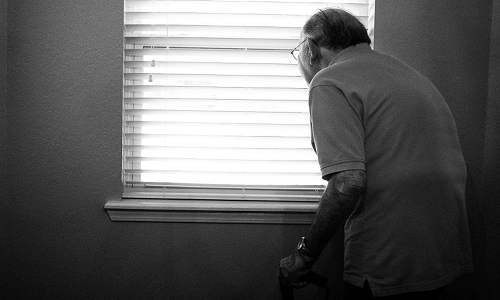The new Aged Care Act, which will come into effect later this year, states that one of its objectives is to assist individuals accessing funded aged care services to live active, self-determined, and meaningful lives. But how are we going to achieve this, while we still medicalise age-related disability and persist in defining support for older people as ‘care’?
 By Hayley Stone, Director of National Disability Policy and Advocacy for Deafness Forum Australia.
By Hayley Stone, Director of National Disability Policy and Advocacy for Deafness Forum Australia.
Over the past few years, we’ve had the opportunity to spotlight the multitude of problems in our disability and aged care sectors. Older Australians, those with disabilities, and their supporters have shared harrowing stories – of abuse, exploitation, violence, and neglect, forcing governments to address the dysfunctionality of the support structures that should provide people with additional support needs decent quality of life.
We’ve also seen the full implementation of the National Disability Insurance Scheme (NDIS), as a world-first, comprehensive support system for people with permanent and significant disability under the age of 65, which has, for the first time, guaranteed people with disability choice and control about the supports and services they need to live their best lives.
For those in policy, comparing the approaches in addressing, what are in many ways, very similar problems, across the aging and disability sectors, is both fascinating and frustrating.
We have different government departments, and different ministers, and the way we draw an arbitrary line in the sand at age 65 around support says much about how as a society, we think about older people and the aging process.
Australia’s Aged Care Scheme is managed by the Department of Health and Aged Care, under the authority of a Minister with the same name. The name of the scheme to my mind is critically important –since it frames the support that it provides in a particular way.
When we think about caring for older people, we think of things like help with showering, home modifications, or support to perform basic daily tasks like cooking or cleaning. We might think about assistive technology, wheelchairs, walkers, and hearing aids. But there’s no association with independence or autonomy.
This view reflects the medicalised model of disability, which links a disability diagnosis to an individual’s physical or cognitive condition. It focuses on the diagnosis, cure, or management of a person’s limitations. Under the medicalized model, a person can be fixed, or at least supported to manage more effectively in society, through targeted support.
Unfortunately, what so often happens is that the individual is lost in the focus on their physical or cognitive limitations. There is little to no scope for the individual to have any choice and control – because they can either do something, or they can’t – with an emphasis on the can’t. As a person’s physical or cognitive limitations increase, so do their supports.
It’s a model that focuses on the reduction of the individual into various deficits to be assessed, and then responded to, through some type of intervention.
It’s not unusual for people with disability who are over 65 years of age to tell me that they wish they could access the National Disability Insurance Scheme instead of the Aged Care Scheme, and I’ve come to understand that a great part of what they are comparing between the two schemes, either consciously or not, is how disability is firstly conceptualised and then addressed in a practical sense to funding and supports.
What makes the National Disability Insurance Scheme so unique in an Australian context – indeed, worldwide, is that the NDIS is a social support scheme founded on a social model of disability. This contemporary approach rejects the idea that the person is the ‘problem’. It recognises that disability is an inherent part of the human condition and that the person with disability is limited not by their characteristics, but instead by external factors that we all have a responsibility to address. These external factors can be physical, attitudinal, or legal.
In recognising the equal value of the individual with disability, the social model acknowledges that that person should have access to the same rights as anyone else, including freedom of expression, self-determination, and decision-making – as seen in the phrase that has become synonymous with the promotion of the NDIS ‘choice and control’ and this is why a participant on the NDIS can, in theory, make decisions about the individual supports they want to align with their personal goals.
The Royal Commission into Aged Care Quality and Safety was established in October 2018 to inquire into the quality of aged care services in Australia, including whether these services met the needs of older people and their families.
The Commission presented its final report in 2021, giving 148 recommendations on improving aged care services. The commission’s first recommendation was that the Government review the Aged Care Act and create a new Act to provide for a system of aged care that allows older Australians to live active, self-determined, and meaningful lives.
The Commission emphasised that the Act should give older Australians the same rights of social participation as other members of society, allow them to make decisions about their care, pursue physical, social, emotional, and intellectual development opportunities and be active and engaged members of their communities, irrespective of age, or level of physical or cognitive capacity – in essence, to bring the Act in line with the social model of disability.
And to the Federal Government’s credit, the draft of the new act does include provisions that should strengthen the rights of older Australians, including a clear statement that the Act is intended to give effect to Australia’s obligations under the International Covenant on Economic, Social and Cultural Rights and the Convention on the Rights of Persons with Disabilities.
But I have doubts that the Act will fully comply with the Commission’s aspirations, so long as we continue to conceptualize our support for older Australians as ‘care’.
To be clear, we certainly do need to provide basic care for any older Australians who require it. All older Australians should have access to basic home and care supports, but what about supports that facilitate aging well, or that support older people to realise personal goals around community participation, capacity building, or learning?
Should older Australians be able to access exercise classes and physiotherapy under the Aged Care Scheme as preventative measures to age better? Should they be supported to participate in community activities that we know will keep them psychologically and cognitively fit and active longer? Paid employment or volunteer work?
What about support and funding to do courses and training if this would support them to live happy, socially connected lives? I believe all these activities should be accessible under our Aged Care Scheme, simply based on common sense –because we know that happy, engaged individuals live healthier.
But there is no way these activities would be defined as ‘care’, and that’s the limitation of our current Aged Care Scheme. The scheme’s basic framing doesn’t facilitate a holistic view of support for older Australians that includes the right to realise their rights as citizens and members of the community in the same way that their NDIS counterparts do, and while this remains the case, it will continue to minimise the Act’s capacity as an instrument to realise the rights of older people in line with our domestic and international obligations.
So, how would we go about addressing this? For a start, we need to go back to basics and reconceptualize the whole scheme to broaden the scope of supports and services available to support older Australians. We’d need to revisit the types of support available to individuals dependent on their individual needs.
It is also important to redefine the portfolio to support the needs – not just care- of older Australians and separate it from the health portfolio to ensure the distinction between the two portfolios doesn’t become blurred.
We also need to change community attitudes around aging. People are living and working longer. They’re working into their 60s or 70s, participating in the volunteer workforce, and often balancing informal caring commitments to older or younger relatives, but as a society, we’ve been slow to adjust our attitudes and expectations around what aging now looks like, and what we should be able to expect in terms of support as we age. The Hon. Bill Shorten, once said to me (and I paraphrase) that the Aged Care Act was great for its time – until we had the NDIS. The reform of the Aged Care Act is a once-in-a-lifetime chance to redefine how we, as a society, support our Elders, both now and into the future.
By acting on the lessons learned from the National Disability Insurance Scheme and integrating a social model of disability, we can reimagine ageing not as a decline to be managed but as a phase of life rich with potential. The reform of the Aged Care Act offers hope for a future where aging is celebrated as a vibrant part of the human experience, ensuring that our elders are respected, valued, and empowered to live good lives. We can take this opportunity to redefine the narrative of ageing in Australia to one of dignity and respect. For everyone of us, no matter their age, it’s personal.

